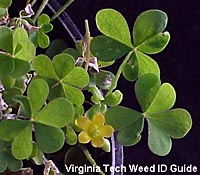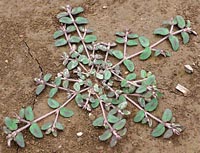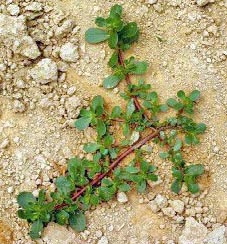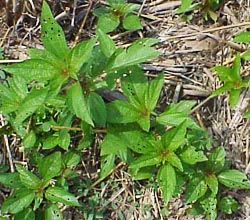Weed Nation

Yellow Woodsorrel
by Ray Novitske, Fairfax Master Gardener
As some weeds begin their annual westward expansion to populate the land (also known as my yard,) they are beginning to carve out distinct territories for themselves. Yes, some do battle with each other for control of one area or another, but many have colonized individual states that are sympathetic to their kind.
Yellow Woodsorrel (Oxalis stricta) began by conquering the state of “Front Cottage Garden” and everything in the front yard. This lightweight, small weed is a perennial, so driving it off the land is difficult. Trailing stems enable easy migration to other lands.

Spotted Suprge
Soft stems break when being pulled out, leaving pieces of plant to grow back and continue on. With full sun, a fertile soil, and ample water, woodsorrel put down roots where it found favorable conditions and will not disappear.
Spotted Spurge (Euphorbia maculata) battled woodsorrel and has taken some territory in “North Sidewalk Garden.” Woodsorrel’s retreat back across the sidewalk left the region open for conquest, so spurge moved in. It signed a pact with Purslane (Portulaca oleracea) and both share that area and live in harmony.

Purslane
This garden is a narrow strip of land on the north shore of the sidewalk, with full sun and concrete providing plenty of hot, dry conditions – just the kind of place spurge and purslane can raise their offspring. Their succulent slippery leaves mean that liquid herbicides just roll off.
The state of “Side Garden” is perfect for Pennsylvania Smartweed (Polygonum pensylvanicum). These guys settle the same areas they populated last year. Their training ground among the taller peonies, rudbeckia, and nicotiana allows them to maneuver in and around the population without being noticed. Then, when fully grown and mature, they spring into action – flowering and sowing mayhem and seeds for generations to come.

Virginia Copperleaf
Virginia Copperleaf (Acalypha virginica) prefers the rich Virginia soils (or any soil for that matter). It invaded “Lower Vegetable Garden” and has found a home there. Copperleaf always looks like it has been through war, with leaves sporting small holes as if being shot. Most photos on the Internet show its leaves with small holes. The state of Kansas considers this plant a native, and I have read that some wildflower seed mixes include it. If anyone included weeds in a seed mix sold to me, I would think someone’s head was full of holes.
The backyard is Nimblewill country (Muhlenbergia schreberi).

Nimblewill
It never ventures far from the shady, poor-soil homeland it loves. Another perennial, nimblewill grows among the lawn grasses and is difficult to boot out without harming the good guys.
Every weed’s state has shown me that each prefers specific soil, water, light, and temperature conditions to thrive. This is true for the vegetables and landscape plants around the yard, but I never thought about weeds adhering to the same rules. The old saying, “Right plant, wrong place,” seems to apply to a weed, too.